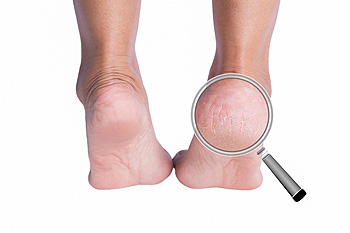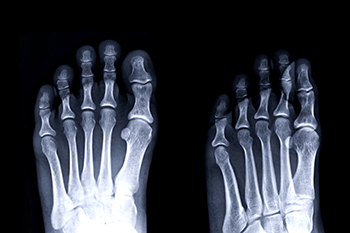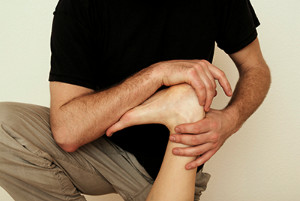Items filtered by date: April 2023
3 Grades of Ankle Sprains

An unexpected fall may result in an ankle sprain. It can happen from suddenly stepping off of a curb and occurs when the ligaments stretch beyond their normal range of motion. Swelling, pain, and an inability to walk are often associated with an ankle sprain and generally require prompt medical attention. A lateral ankle sprain happens when the foot rolls inward while damaging the outer ankle. It is less common to injure the inner ankle, and a syndesmotic sprain may happen during a contact sport. Sprains are categorized into three grades, based on severity. When the ligaments are mildly stretched and accompanied by minimal pain and swelling, this may be a Grade 1 sprain. A partially torn ligament may produce moderate pain, and will fall into the Grade 2 sprain. Finally, a Grade 3 sprain consists of intense pain, and the patient is unable to walk. If you have sprained your ankle, it is suggested that you seek the counsel of a podiatrist who can help you with proper treatment methods.
Ankle sprains are common but need immediate attention. If you need your feet checked, contact Matthew McQuaid, DPM from Lake Mendocino Podiatry. Our doctor can provide the care you need to keep you pain-free and on your feet.
How Does an Ankle Sprain Occur?
Ankle sprains take place when the ligaments in your ankle are torn or stretched beyond their limits. There are multiple ways that the ankle can become injured, including twisting or rolling over onto your ankle, putting undue stress on it, or causing trauma to the ankle itself.
What Are the Symptoms?
- Mild to moderate bruising
- Limited mobility
- Swelling
- Discoloration of the skin (depending on severity)
Preventing a Sprain
- Wearing appropriate shoes for the occasion
- Stretching before exercises and sports
- Knowing your limits
Treatment of a Sprain
Treatment of a sprain depends on the severity. Many times, people are told to rest and remain off their feet completely, while others are given an air cast. If the sprain is very severe, surgery may be required.
If you have suffered an ankle sprain previously, you may want to consider additional support such as a brace and regular exercises to strengthen the ankle.
If you have any questions please feel free to contact our offices located in Lakeport and Ukiah, CA . We offer the newest diagnostic and treatment technologies for all your foot and ankle needs.
Wounds That Don't Heal Need to Be Checked
Dry, Cracked Heels in Children

Children can get dry, cracked heels, and this can interfere with their active functioning. Cracked heels can occur in children for several reasons, including fungal infections, taking long and hot baths, obesity, and skin allergies. Drinking lots of water and good nutrition, which should include proper vitamins and nutrients, can help with dry, cracked heels in kids. Keeping feet clean, dry, and moisturized may also help prevent fungal and bacterial infections, such as athlete’s foot, often resulting in dry, cracked heels. Obese children can suffer from increased pressure on their feet, leading to cracked skin. If a child is obese, actions to bring a child’s weight into the normal range are suggested. Of course, if a child appears to get a skin reaction from a new product or some other irritant, it should be stopped immediately. Since dry, cracked heels have varied causes, it is suggested to take them to a podiatrist for an examination and treatment if this is something your child suffers from.
Cracked heels are unsightly and can cause further damage to your shoes and feet. If you have any concerns, contact Matthew McQuaid, DPM from Lake Mendocino Podiatry. Our doctor can provide the care you need to keep you pain-free and on your feet.
Cracked Heels
Cracked heels appear unappealing and can make it harder for you walk around in sandals. Aside from looking unpleasant, cracked heels can also tear stockings, socks, and wear out your shoes. There are several methods to help restore a cracked heel and prevent further damage.
How Do You Get Them?
Dry skin is the number one culprit in creating cracked heels. Many athletes, walkers, joggers, and even swimmers suffer from cracked heels. Age and skin oil production play a role to getting cracked heels as well.
Promote Healing
Over the counter medicines can help, especially for those that need instant relief or who suffer from chronic dry feet.
Wear Socks – Wearing socks with medicated creams helps lock in moisture.
Moisturizers – Applying both day and night will help alleviate dryness which causes cracking.
Pumice Stones – These exfoliate and remove dead skin, which allows for smoother moisturizer application and better absorption into the skin.
Change in Diet
Eating healthy with a well-balanced diet will give the skin a fresh and radiant look. Your body responds to the kinds of food you ingest. Omega-3 fatty acids and zinc supplements can also revitalize skin tissue.
Most importantly, seek professional help if unsure how to proceed in treating cracked heels. A podiatrist will help you with any questions or information needed.
If you have any questions, please feel free to contact our offices located in Lakeport and Ukiah, CA . We offer the newest diagnostic and treatment technologies for all your foot care needs.
Recovery Time for a Stress Fracture to Heal

Repetitive overuse is often the reason why stress fractures happen. Many runners endure this foot condition from the miles and hours they spend running. Stress fractures may cause their running routine to temporarily stop. A stress fracture is defined as a hairline crack in the bone and can affect any of the foot bones. Excessive running or similar activities may cause the muscles to become tired and unable to absorb the impact as the foot strikes the ground. The bone will naturally take on this task, which can result in a stress fracture. It can be confirmed by having an X-ray performed, which precedes beginning treatment. It is beneficial to rest the foot as often as possible, and it may help to use crutches to keep weight off of the foot. The majority of patients who endure stress fractures will completely heal in approximately six weeks, and it is helpful to perform stretches that can strengthen the foot. If you have a stress fracture of the foot, it is suggested that you consult with a podiatrist who can offer you additional treatment options.
Activities where too much pressure is put on the feet can cause stress fractures. To learn more, contact Matthew McQuaid, DPM from Lake Mendocino Podiatry. Our doctor can provide the care you need to keep your pain free and on your feet.
Dealing with Stress Fractures of the Foot and Ankle
Stress fractures occur in the foot and ankle when muscles in these areas weaken from too much or too little use. The feet and ankles then lose support when walking or running from the impact of the ground. Since there is no protection, the bones receive the full impact of each step. Stress on the feet can cause cracks to form in the bones, thus creating stress fractures.
What Are Stress Fractures?
Stress fractures occur frequently in individuals whose daily activities cause great impact on the feet and ankles. Stress factors are most common among:
- Runners
- People affected with Osteoporosis
- Tennis or basketball players
- Gymnasts
- High impact workouts
Symptoms
Pain from the fractures occur in the area of the fractures and can be constant or intermittent. It will often cause sharp or dull pain with swelling and tenderness. Engaging in any kind of activity which involves high impact will aggravate pain.
If you have any questions please feel free to contact our offices located in Lakeport and Ukiah, CA . We offer the newest diagnostic and treatment technologies for all your foot and ankle needs.
Foot Stretches for Swimming

Many individuals may partake in swimming, whether it be a triathlete or a casual swimmer. Before one engages in this activity, however, it may be beneficial to perform certain foot stretches. For example, a swimmer can increase ankle flexibility and mobility by performing several ankle stretches and motions. Specifically, while wrapping a band around the bottom of the foot and holding it with the hands, an individual can flex the ankle against resistance. By repeatedly pointing the toes against this resistance, one can ultimately improve tissue length near the ankle. If you are someone who frequently swims and you want to learn more about ways in which you can stretch the foot, then it is suggested that you are under the care of a podiatrist. This foot specialist can help you answer any questions you might have and provide any treatment you may need.
Stretching the feet is a great way to prevent injuries. If you have any concerns with your feet consult with Matthew McQuaid, DPM from Lake Mendocino Podiatry. Our doctor will assess your condition and provide you with quality foot and ankle treatment.
Stretching the Feet
Being the backbone of the body, the feet carry your entire weight and can easily become overexerted, causing cramps and pain. As with any body part, stretching your feet can serve many benefits. From increasing flexibility to even providing some pain relief, be sure to give your feet a stretch from time to time. This is especially important for athletes or anyone performing aerobic exercises, but anyone experiencing foot pain or is on their feet constantly should also engage in this practice.
Great ways to stretch your feet:
- Crossing one leg over the others and carefully pull your toes back. Do 10-20 repetitions and repeat the process for each foot
- Face a wall with your arms out and hands flat against the wall. Step back with one foot and keep it flat on the floor while moving the other leg forward. Lean towards the wall until you feel a stretch. Hold for 30 seconds and perform 10 repetitions for each foot
- Be sure not to overextend or push your limbs too hard or you could risk pulling or straining your muscle
Individuals who tend to their feet by regular stretching every day should be able to minimize foot pain and prevent new problems from arising.
If you have any questions, please feel free to contact our offices located in Lakeport and Ukiah, CA . We offer the newest diagnostic and treatment technologies for all your foot care needs.

